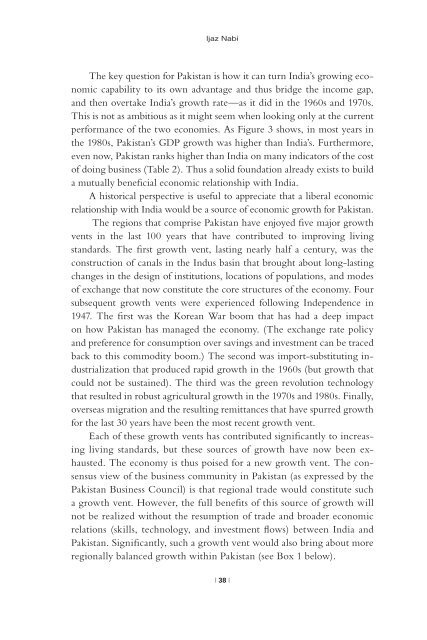You also want an ePaper? Increase the reach of your titles
YUMPU automatically turns print PDFs into web optimized ePapers that Google loves.
Ijaz Nabi<br />
The key question for <strong>Pakistan</strong> is how it can turn <strong>India</strong>’s growing economic<br />
capability to its own advantage and thus bridge the income gap,<br />
and then overtake <strong>India</strong>’s growth rate—as it did in the 1960s and 1970s.<br />
This is not as ambitious as it might seem when looking only at the current<br />
performance of the two economies. As Figure 3 shows, in most years in<br />
the 1980s, <strong>Pakistan</strong>’s GDP growth was higher than <strong>India</strong>’s. Furthermore,<br />
even now, <strong>Pakistan</strong> ranks higher than <strong>India</strong> on many indicators of the cost<br />
of doing business (Table 2). Thus a solid foundation already exists to build<br />
a mutually beneficial economic relationship with <strong>India</strong>.<br />
A historical perspective is useful to appreciate that a liberal economic<br />
relationship with <strong>India</strong> would be a source of economic growth for <strong>Pakistan</strong>.<br />
The regions that comprise <strong>Pakistan</strong> have enjoyed five major growth<br />
vents in the last 100 years that have contributed to improving living<br />
standards. The first growth vent, lasting nearly half a century, was the<br />
construction of canals in the Indus basin that brought about long-lasting<br />
changes in the design of institutions, locations of populations, and modes<br />
of exchange that now constitute the core structures of the economy. Four<br />
subsequent growth vents were experienced following Independence in<br />
1947. The first was the Korean War boom that has had a deep impact<br />
on how <strong>Pakistan</strong> has managed the economy. (The exchange rate policy<br />
and preference for consumption over savings and investment can be traced<br />
back to this commodity boom.) The second was import-substituting industrialization<br />
that produced rapid growth in the 1960s (but growth that<br />
could not be sustained). The third was the green revolution technology<br />
that resulted in robust agricultural growth in the 1970s and 1980s. Finally,<br />
overseas migration and the resulting remittances that have spurred growth<br />
for the last 30 years have been the most recent growth vent.<br />
Each of these growth vents has contributed significantly to increasing<br />
living standards, but these sources of growth have now been exhausted.<br />
The economy is thus poised for a new growth vent. The consensus<br />
view of the business community in <strong>Pakistan</strong> (as expressed by the<br />
<strong>Pakistan</strong> Business Council) is that regional trade would constitute such<br />
a growth vent. However, the full benefits of this source of growth will<br />
not be realized without the resumption of trade and broader economic<br />
relations (skills, technology, and investment flows) between <strong>India</strong> and<br />
<strong>Pakistan</strong>. Significantly, such a growth vent would also bring about more<br />
regionally balanced growth within <strong>Pakistan</strong> (see Box 1 below).<br />
| 38 |


